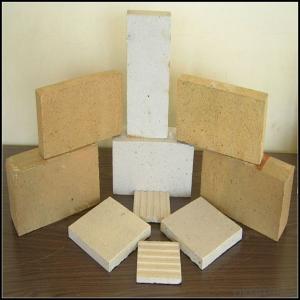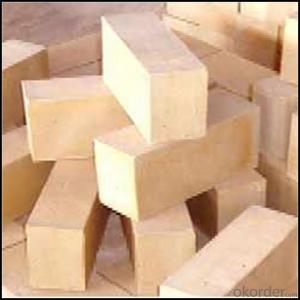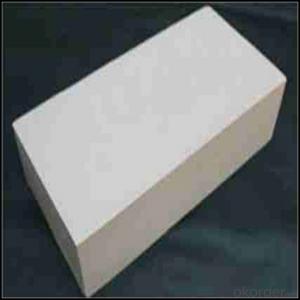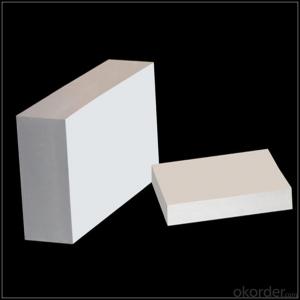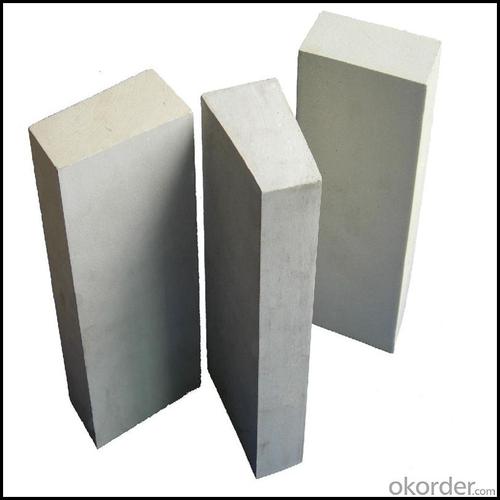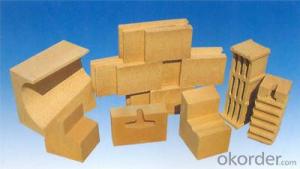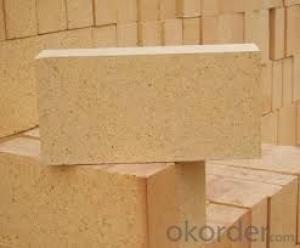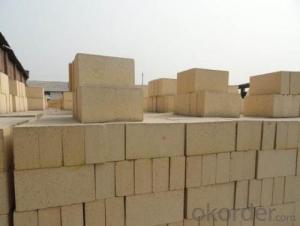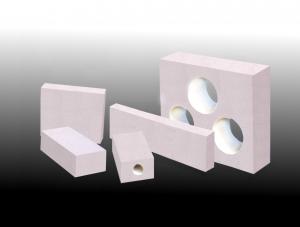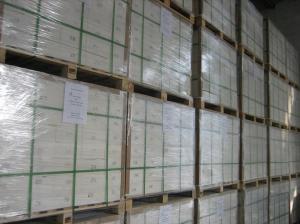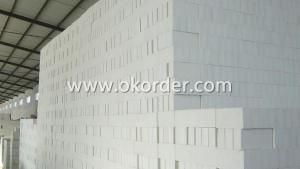High Alumina Insulating Fire Brick
- Loading Port:
- China main port
- Payment Terms:
- TT OR LC
- Min Order Qty:
- 0.01
- Supply Capability:
- 1800 m.t/month
OKorder Service Pledge
OKorder Financial Service
You Might Also Like
Acid Resistant Brick
CMAX firebricks are classified under temperature between 1300℃ to 1700℃, manufactured from high purity alumina clay by mixing, press-forming, drying, sintering and machining. Bricks contain carefully-graded organic fillers which are burned out during sintering to give a uniform controllable pore structure. This technique makes product feature low thermal conductivity and excellent heat insulation
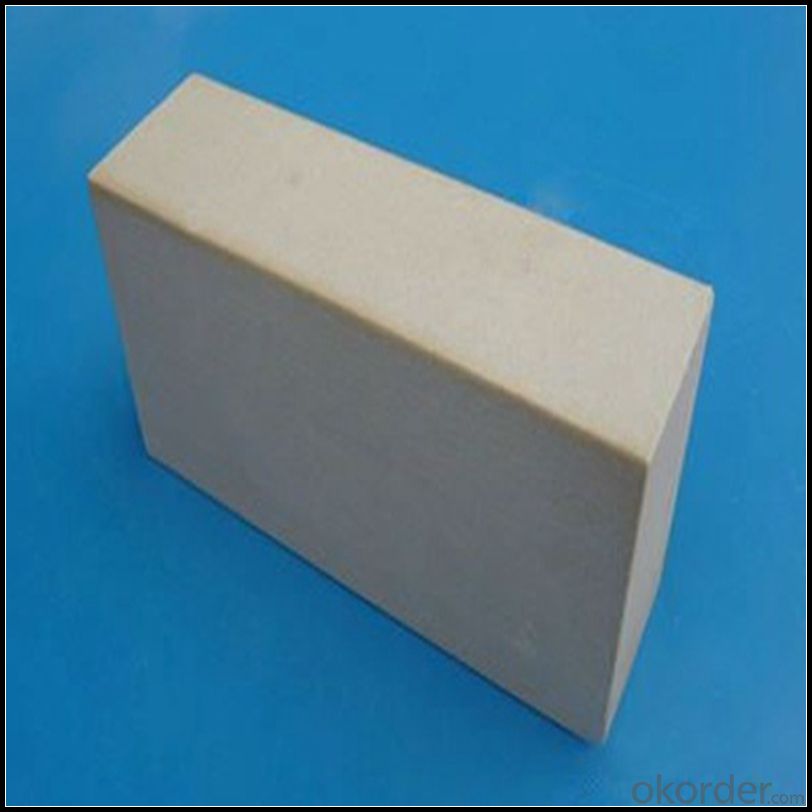
Features
Product features :
1. High temperature resistant,
2. Performance is good,
3. High strength,
4. Show low porosity,
5. An acid, alkali resistant, aggressive good, etc
Application
Mainly used for thermal boilers, cement kiln, glass furnace, gas furnace, fertilizer, blast furnace hot-blast stove, coking furnace, electric furnace, casting and casting steel brick.
Data Sheet
Classification Temperature (℉/℃) | 3000/1650 |
Bulk Density (g/cm3 ) | ≤1.0 |
Thermal Conductivity | |
800℃, W/m.K | ≤0.39 |
1000℃, W/m.K | ≤0.43 |
1200℃, W/m.K | ≤0.48 |
Reheating Linear Change (%) | 1550℃×12h |
≤0.9 | |
Chemical Composition (%) | |
Al2O3 | ≥75 |
Fe2O3 | ≤0.5 |
Packaging & Shipping
Packaging Details:Be packed in fumigated wooden pallets
Delivery Detail: 30 days after order

Our Services
Optimum solution and product supply of refractories for high temperature industries, such as iron steel, non-ferrous, petrochemical and building materials.
Engineering design, contract and consult for refractories, and civil architecture design.
Research, development, manufacture and sale of superhard materials.
R&D, manufacture and sale of special packing materials for export.
Inspection, supervision and arbitration of refractories.
Consultation and services in refractories information.
Training and cultivation of high-level talents in refractories profession
Sales Network

Company Information
CNBM (China National Building Material) Group is the largest comprehensive building materials group in China that in integrate scientific research, manufacturing and logistics into one entity. The largest building materials and equipment specialists in China. Upon State Council approval, today CNBM owned more than 300 subordinate manufacturing factories and servicing companies. There are 6 fully owned public listed companies and 11 partially owned with substantial shares public listed companies. In many of these fields, CNBM is playing the leading role in the building industry in the country.
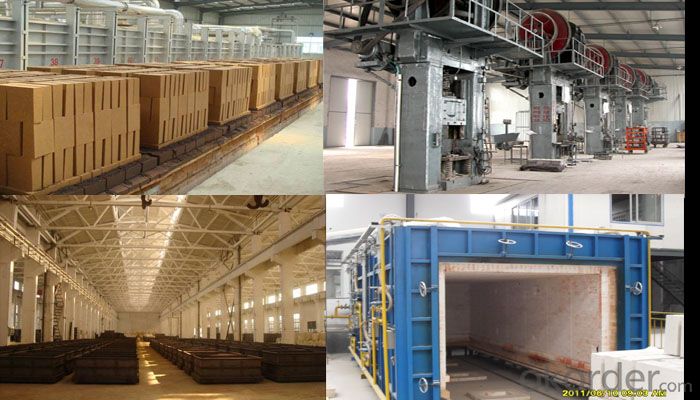
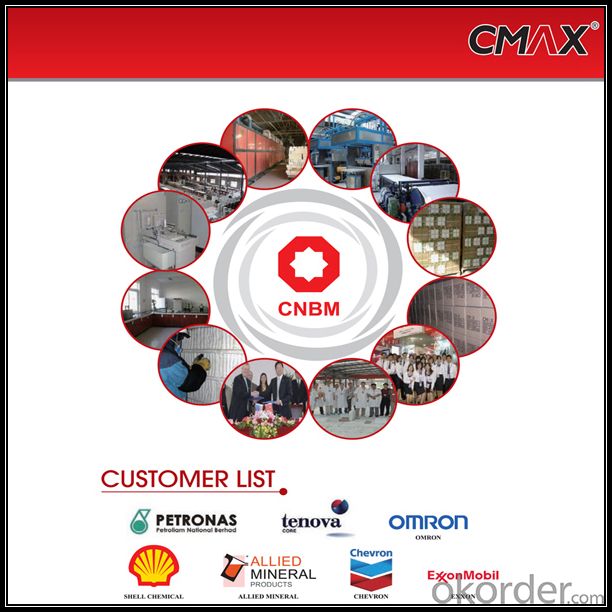
FAQ
1. Which products do you have?
We have all kinds of refractory brick, castable, mortar, cement, ceramic fiber products, etc.
Or you could browse our products to choose what you need.
2. Can you give me a brief introduction of the application of your products?
We are mainly specializing in the refractory materials in iron and steel, cement, glass, ceramics, petrochemical, electric power Industry, etc.
3. If I need your offer, what information do you need?
In order to choose suitable products, it will be appreciated to provide us the information, such us specification, technical data, order quantity, products application etc. If any question, please contact us freely.
- Q: How do insulating fire bricks help improve the efficiency of heat treatment processes?
- Insulating fire bricks help improve the efficiency of heat treatment processes by effectively reducing heat loss. Due to their low thermal conductivity, these bricks act as a barrier, preventing heat from escaping and maintaining high temperatures for longer periods. This allows the heat treatment process to be more energy-efficient, as less energy is required to achieve and maintain the desired temperatures. Additionally, insulating fire bricks help to evenly distribute heat, resulting in more consistent and uniform heat treatment outcomes.
- Q: Are insulating fire bricks resistant to high-velocity gas flow erosion?
- Yes, insulating fire bricks are generally resistant to high-velocity gas flow erosion. These bricks are designed to withstand high temperatures and are made from materials that can withstand the erosive effects of gases flowing at high velocities. However, the resistance may vary depending on the specific composition and quality of the fire bricks.
- Q: Can insulating fire bricks be used as insulation in walls and roofs?
- Yes, insulating fire bricks can be used as insulation in walls and roofs. Insulating fire bricks are made from lightweight materials that have excellent thermal insulation properties. They have low thermal conductivity, which means they can effectively reduce heat transfer through walls and roofs. This makes them a suitable choice for insulating buildings and improving energy efficiency. Additionally, insulating fire bricks are durable and fire-resistant, making them a safe option for insulation. However, it is important to note that insulating fire bricks are typically used in high-temperature applications such as furnaces and kilns, so they may not be the most cost-effective or practical choice for all wall and roof insulation needs. Other insulation materials designed specifically for building applications may be more suitable in terms of cost, ease of installation, and overall performance.
- Q: Are insulating fire bricks resistant to chemical attack?
- Yes, insulating fire bricks are generally resistant to chemical attack. They are designed to withstand high temperatures and are made from materials that are chemically inert, making them suitable for various industrial applications where exposure to chemicals is a concern. However, the specific resistance may vary depending on the type of chemical and concentration, so it is important to consider the specific chemical environment when selecting insulating fire bricks.
- Q: Can insulating fire bricks be used in the construction of lime kilns?
- Insulating fire bricks are perfectly suitable for the construction of lime kilns. These bricks are specifically designed to have low thermal conductivity, giving them exceptional insulation properties. As a result, they are ideal for use in lime kilns, which require high temperatures for the calcination process. Lime kilns typically operate within the temperature range of 900 to 1200 degrees Celsius. To ensure efficient and effective lime production, it is crucial to contain the intense heat generated during this process within the kiln. Insulating fire bricks play a vital role in achieving this by minimizing heat loss through the kiln walls, enabling higher energy efficiency and reducing operating costs. Moreover, insulating fire bricks offer the advantage of being lightweight and easy to handle, making them highly convenient for construction purposes. They can be easily shaped and cut to fit the specific design requirements of the lime kiln, ensuring a secure and tight fit. Furthermore, these fire bricks possess excellent resistance to thermal shock, which is of utmost importance in lime kilns where rapid temperature changes occur during the firing process. This resistance helps prevent cracking and structural damage, ensuring the longevity and durability of the kiln. To summarize, insulating fire bricks are an excellent choice for the construction of lime kilns due to their low thermal conductivity, lightweight nature, ease of shaping, and resistance to thermal shock.
- Q: Can insulating fire bricks be used in ceramic industry kilns?
- Indeed, insulating fire bricks find utility in the kilns of the ceramic industry. These bricks are specially crafted to endure extreme temperatures and offer insulation within kilns. With their low thermal conductivity, they facilitate the preservation of uniform heat distribution, thus enhancing the efficiency of firing procedures. Moreover, their lightweight nature simplifies their handling and installation in kilns. The bricks' capacity to retain heat and withstand thermal shock renders them an optimal selection for employment in ceramic industry kilns.
- Q: Can insulating fire bricks be used for insulation in hot blast stoves?
- Yes, insulating fire bricks can be used for insulation in hot blast stoves. Insulating fire bricks are designed to withstand high temperatures and have excellent thermal insulation properties. They are made from lightweight materials with low thermal conductivity, which allows them to effectively retain heat and prevent heat transfer to the surrounding environment. In hot blast stoves, where temperatures can reach extremely high levels, insulating fire bricks can help maintain high temperatures inside the stove while minimizing heat loss. This not only improves the energy efficiency of the stove but also helps to protect the structure from excessive heat. Therefore, using insulating fire bricks for insulation in hot blast stoves is a common and effective practice.
- Q: Can insulating fire bricks be used in foundries?
- Yes, insulating fire bricks can be used in foundries. They are commonly used as lining materials for various high-temperature applications, including foundries. Insulating fire bricks provide excellent thermal insulation, reducing heat loss and improving energy efficiency in the foundry process. Additionally, they have good resistance to thermal shock and can withstand the extreme temperatures and harsh conditions often found in foundry environments.
- Q: Can insulating fire bricks be used for high-temperature applications?
- Insulating fire bricks are widely employed for applications involving high temperatures. These bricks have been crafted to offer exceptional thermal insulation and endure extreme temperatures. Depending on the specific type and composition of the brick, they can typically withstand temperatures of up to 2600°F (1427°C) or even higher. Kilns, furnaces, and industrial settings that necessitate high temperatures commonly utilize insulating fire bricks. These bricks are renowned for their minimal thermal conductivity, which aids in reducing heat loss and enhancing energy efficiency. Moreover, these bricks possess the advantages of being lightweight, long-lasting, and resistant to thermal shock, rendering them ideal for environments with elevated temperatures.
- Q: Can insulating fire bricks be used in waste incineration plants?
- Yes, insulating fire bricks can be used in waste incineration plants. Insulating fire bricks are designed to withstand high temperatures, making them suitable for use in the extremely hot environment of waste incineration plants. These bricks are made from lightweight materials that have excellent thermal insulation properties, which helps to reduce heat loss and improve energy efficiency in the incineration process. Additionally, insulating fire bricks have good resistance to chemical and thermal shock, which is important in waste incineration plants where various types of waste materials are burned. Overall, the use of insulating fire bricks in waste incineration plants can contribute to better insulation, higher energy efficiency, and improved performance of the incineration process.
Send your message to us
High Alumina Insulating Fire Brick
- Loading Port:
- China main port
- Payment Terms:
- TT OR LC
- Min Order Qty:
- 0.01
- Supply Capability:
- 1800 m.t/month
OKorder Service Pledge
OKorder Financial Service
Similar products
Hot products
Hot Searches
Related keywords
